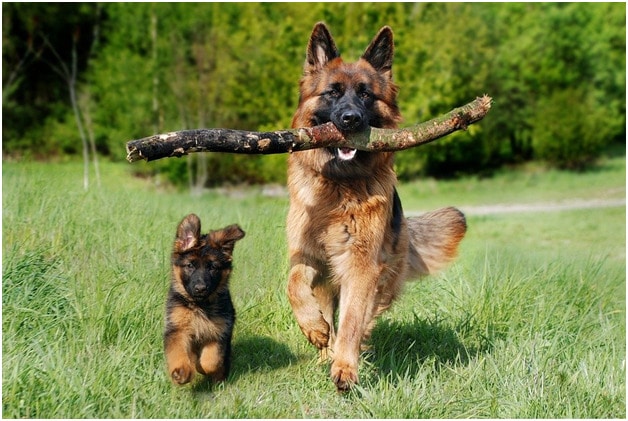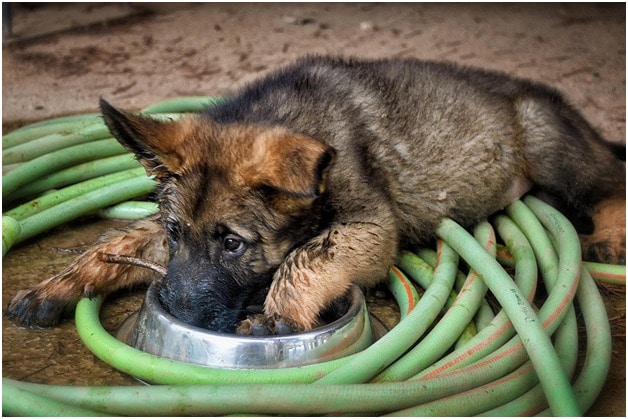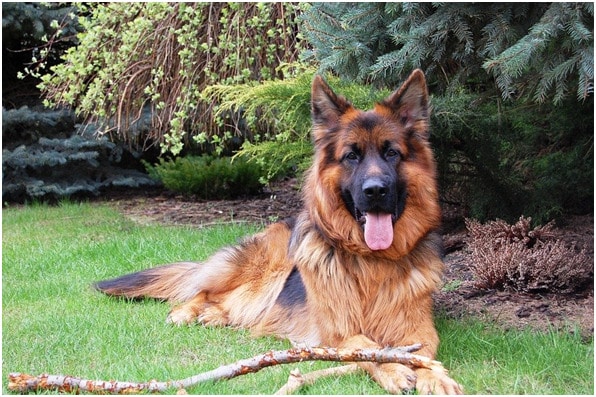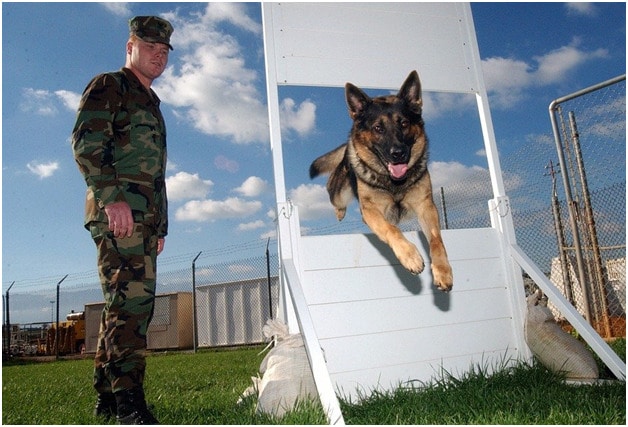German Shepherds are well known for their loyalty, courage, and guarding instincts, however, are they agile?
They also play a big role in the military, but also as police and guide dogs. However, this leaves many people wondering, are these dogs as great at agility as they are at helping humans?
So, are German Shepherds agile?
German Shepherds are quite agile, and they are easy to train for agility purposes. These dogs are flexible and have quick reaction times, hence their frequent contribution to the military and use as police dogs.
There is a lot more to know when it comes to German Shepherds and their agility, therefore, be sure to stick around as we reveal plenty of cool information you never knew before!

Are German Shepherds Built for Agility?
German Shepherds were bred to be agile, so these dogs are usually very active. They are perfect for large yards with high fences because they have the ability to jump over them. They are generally well-behaved, making them great pets for families and active individuals.
Being a herding breed, German Shepherds were originally bred to protect and herd sheep and other farm animals. They were capable of clambering over fences with ease during these tasks, but now they mostly live in cities and suburbs as family pets.
As family pets, German Shepherds are usually more interested in playing with children or other dogs than climbing fences. However, if their activity needs are not met they will make their own fun by getting into things around the house.
For this reason, it is important for owners to make sure these pups get plenty of outdoor time and sufficient exercise.

When it comes to agility, German Shepherds have generally been ranked as one of the best breeds in terms of jumping and climbing abilities. Their muscular build makes them very quick, and their stamina enables them able to keep up for longer distances without tiring out.
While they are not usually built for speed, they can still manage a sprint from time to time which helps these dogs complete agility courses faster than other dogs.
However, young, and inexperienced German Shepherds may be more likely to injure themselves when running at full speed because they haven’t yet developed strong muscles and bones that will allow them to run safely.
Regardless of if you’re thinking about getting into dog sports or simply want a pet that is active enough for your family’s lifestyle, German Shepherds can be wonderful dogs for the right home.
When Should You Start German Shepherd Agility Training?
There is no definitive answer to this question because every dog is different.
Some of these dogs may take to agility training easily while others might need more time adapting to it. Regardless of the breed, some dogs are more sensitive than others and won’t do well with certain things, like barriers or obstacles that they can’t see on the ground.
However, there are some general guidelines you can follow to maximize your German Shepherd’s agility skills.
The best time for starting training with a new pup is around 12 weeks of age (8 weeks for rescue puppies). This way, the pup will be getting used to life outside the litter and their new home without becoming too fixated on their old pack dynamics.
They’ll also be less stressed about being around humans and other dogs because they won’t have an idea who those people or dogs are yet.
However, should you plan to start agility training with your German Shepherd at a young age, be sure to move slow – and we mean very slow.
Puppies need to be careful and should avoid jumping or running too much as this can be hard on their joints and even cause them to develop problems with their hips down the road.
Other keys points for maximizing your German Shepherd’s agility skills are understanding how they think, being patient, and having fun.
Some of these dogs have a mind of their own so you’ll need to be creative with training – no cookie-cutter approach will work here!

They love to play so it might help to try playing some games by themselves too. An example would be draping an old t-shirt on the ground where you want them to walk over it.
You can then guide them under or through it as part of their warmup routines which will better prepare them for more difficult obstacles later on.
However, it’s important not to force anything onto your dog if they don’t want to do it. Some dogs might just not like chasing after a toy with you and that’s okay – they can still learn agility skills without playing games with their favorite toys!
Is Agility Training Good for German Shepherds?
One of the things that people love about these German shepherds is their agility. Agility training is very good for German Shepherds because it will help you keep them healthy and train them to be active.
Not only is watching your German Shepherd’s agility impressive, but it also helps build a bond between you and your dog. It’s a good way to get your German shepherd some exercise and also have a great time training your dog.
If you are interested in agility with your pet, make sure that you sign up for classes early on. You will need to start working on training them when they are puppies because it doesn’t come naturally for all German Shepherds.
Plus, it is better to start with young dogs because an old dog might be set in its ways by now and not want to learn new tricks.

What slows down agility training?
There are many factors that can slow down the process of learning agility.
One major factor is the animal’s age. Older dogs may be slower due to their joints, but what about younger ones? Younger dogs are often not as confident in themselves and might need more time to build up their confidence before they will run at full speed through obstacles.
Fearfulness can also impede a dog’s ability to learn these skills quickly, particularly if it has been hurt before while playing or running on an obstacle course.
Finally, there are injuries that can affect how well a dog learns new tricks-and these too should be treated by a veterinarian, so they do not keep slowing down progress.
Does Agility Training Build Confidence?
In the past, German Shepherds were bred to guard sheep against predators and lead them. They have been so successful at this job that they have become a favorite breed for families, police officers, and more!
With the variety of jobs that these dogs can take on in their lifetime, it is important to work on training them.
One way to help your dog gain confidence is by practicing agility training. This will teach your dog how to jump over obstacles and go through tunnels-all of which will build the self-confidence of your pup by rewarding tasks that are completed successfully.
Not only will agility training build confidence in your shepherd, but it will also build trust in you! When you show your pup that the two of you can work together to overcome challenges, they will develop deep trust in your relationship.
This is also incredibly helpful for police dogs because it builds teamwork and trust with their partners.
How To Start Agility Training With a German Shepherd
If you have made it this far in the article, chances are, you may be considering getting started with some agility training with your four-legged friend.
Thankfully, we have some tips to help you on this journey!
German Shepherds can be trained to be agile, by practising the following:
- Introduce your dog to new and different surfaces. This can be done by taking your pup for walks on different terrain or grass types, such as wet grass and stone surfaces.
- Teach him what agility obstacles are. Agility obstacles vary in height, length, width, and texture. Show him some on video so he knows what to expect!
- Play games that increase his muscular strength. There are many games you can play with your dog that will help them become stronger and more agile-such as “tug of war,” “touch the toes” and “find it.”
- Practice your playing. The more you play with your dog the better he will be able to tolerate agility obstacles. Make sure that when you are playing these games, you are practicing different types of agility obstacles so that he is familiarizing himself with them. If you are just starting out, try introducing him to a cone and gradually build up to physical objects like bars and logs as he becomes more comfortable.
What Agility Training Equipment is Needed?
Agility training requires a variety of equipment in order to practice basic skills, but it does not require any type of exercise equipment. The only two things that are necessary are a leash and a large open area where the dog will have plenty of room to run.
You can, of course, add more to this list once your dog learns some basic agility tricks. Some great additions for your agility training could include jumps, poles, and even tunnels.
Adding some variety to your dog’s agility training will help keep things interesting, and it will also allow your dog to maintain a high level of agility as he or she grows older.
One type of exercise equipment you can use for agility training is the Agility A-Frame Ramp.
This piece of equipment is very versatile because you can use it indoors or outdoors while teaching your German Shepherd to climb up on furniture or where he or she cannot normally go without you lifting them up.
It may be difficult at first, but with consistent practice, this specific agility trick will come naturally to him or her.
Another thing that some owners decide to add is obstacles in their backyard. This way they don’t have to travel anywhere else besides their yard when practicing new tricks with their dogs.
The only obstacle that every German Shepherd owner needs is a jump. This will be useful for getting over walls, hedges, and even low fences with ease.

A tunnel is also an excellent addition because it forces the dog to have better focus while transitioning through the obstacle without any problems.
Speaking of tunnels, you can purchase some inexpensive agility equipment that works perfectly for your backyard training sessions.
For example, the Agility Tunnel & Tires are made of heavy-gauge PVC that can easily be brought inside or outside within minutes. It rolls up nicely when not in use so it won’t take up much room at all when you decide to store it away until next time!
Another benefit of having some fun agility obstacles in your backyard is being able to train your dog when it is raining and there isn’t anything else you can do outside.
If your dog is a little hesitant about using the equipment at first, start out slow and try having him or her walk through each obstacle one by one while rewarding them for their obedience.
Final thoughts

There is no doubt that German Shepherds are very agile, as long as they have the right training. No dog is going to be super agile unless you practice agility training with them.
It is therefore crucial to keep a consistent agility training schedule for your German Shepherd if you wish to see results.
Most importantly, however, is to never forget that you should not push your dog further than they are willing to go.
If they are not interested or comfortable enough to try something new, consider ending the training session early, or moving to a different challenge that may seem more appealing to them.


